Lecture 1
...
showdown of innate and adaptive immunity: SARS CoV-2 example
does decrease seen now mean pandemic is over?
No herd immunity bc of rate of mutation
people have pre existing immunity as infected, and then if re infected by NEW strains, they are still less impacted by it
believe virus cannot be eradicated
believe it would become endemic - there have been enough infections
- not guarantee bc a mutation can change it and override others
what is first line of immune defense against SARS CoV-2?
Barriers:
-
mechanical/physical
- ex: mucus, mucociliary escalator, cell membranes and tight junctions
-
chemical
- ex: mucus, surfactants made in alveoli
-
microbiological
- ex: "normal" microbiota
Mucus rest on cilia (hair structures that rhythmically beat upwards, whatever stick on mucus will get pushed up to mouth and swallow it and it gets destroyed/killed in GI tract/stomach (at least majority of pathogens) bc of low pH of 2 and other enzymes attack the virus
Surfactants – proteins made in air sacs, and are thought of as soap (form micelles) and have ability to invade in way to attack biological membranes
Microbiota – almost nothing known of microbiota of upper airways - bc would need endoscope to collect (would need to be under anesthesia)
How does SARS CoV-2 breach the barrier of the respiratory tract?
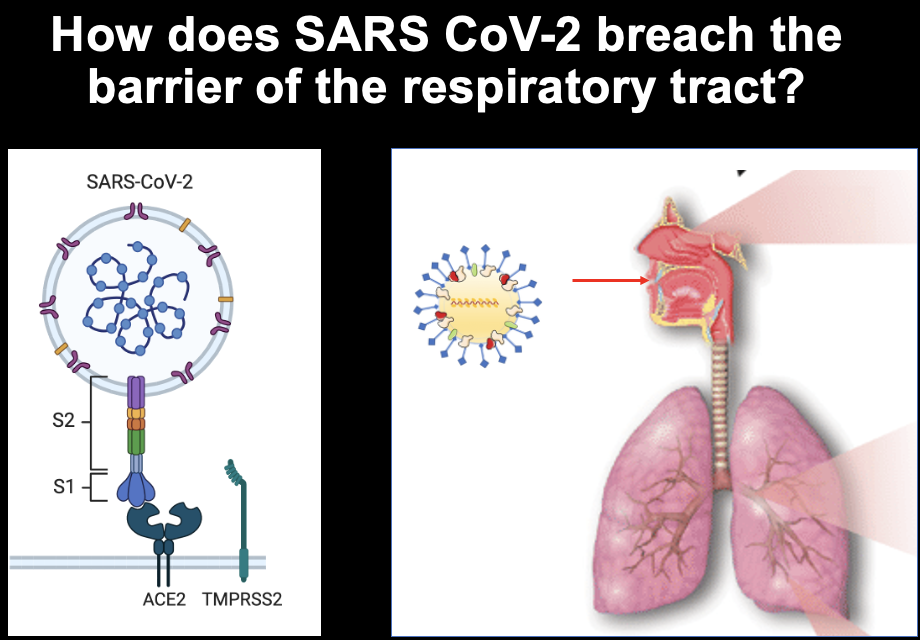
Proteins imbedded in the capsid are recognized by receptor in ambular cells in resp track
- receptor for SARS covid 2 virus is ACE 2
- these ACE 2 receptors normally do other things as well
Important to recognize that virus must enter, and there are specific mechanisms
- like getting through barriers and also getting into cells
Can ACE 2 receptors in olafactory cells be affected by covid?
- symptom of covid – lose smell
- and olafactory nerves have to do with smell
FROM ONLINE:
SARS-CoV-2 must overcome seven constitutive respiratory defense barriers. - The first is the mucus covering the respiratory tract’s luminal surface, which entraps inhaled particles, including infectious agents, and eliminates them by mucociliary clearance.
- The second barrier comprises various components present in the airway lining fluid, the surfactants. Besides providing low surface tension that allows efficient gas exchange at the alveoli, surfactants inhibit the invasion of epithelial cells by respiratory viruses, enhance pathogen uptake by phagocytes, and regulate immune cells’ functions.
- The respiratory tract microbiota constitutes the third defense barrier against SARS-CoV-2. It activates the innate and adaptive immune cells and elicits anti-infectious molecules such as secretory IgA antibodies, defensins, and interferons.
- The fourth defense barrier comprises the antimicrobial peptides defensins, and lactoferrin. They show direct antiviral activity, inhibit viral fusion, and modulate the innate and adaptive immune responses.
- Secretory IgA antibodies, the fifth defense barrier, besides protecting the local microbiota against noxious agents, also inhibit SARS-CoV-2 cell invasion.
- If the virus overcomes this barrier, it reaches its target, the respiratory epithelial cells. However, these cells also act as a defense barrier, the sixth one, since they hinder the virus’ access to receptors and produce antiviral and immunomodulatory molecules such as interferons, lactoferrin, and defensins.
- Finally, the sensing of the virus by the cells of innate immunity, the last constitutive defense barrier, elicits a cascade of signals that activate adaptive immune cells and may inhibit the development of productive infection
what happens upon viral entry?
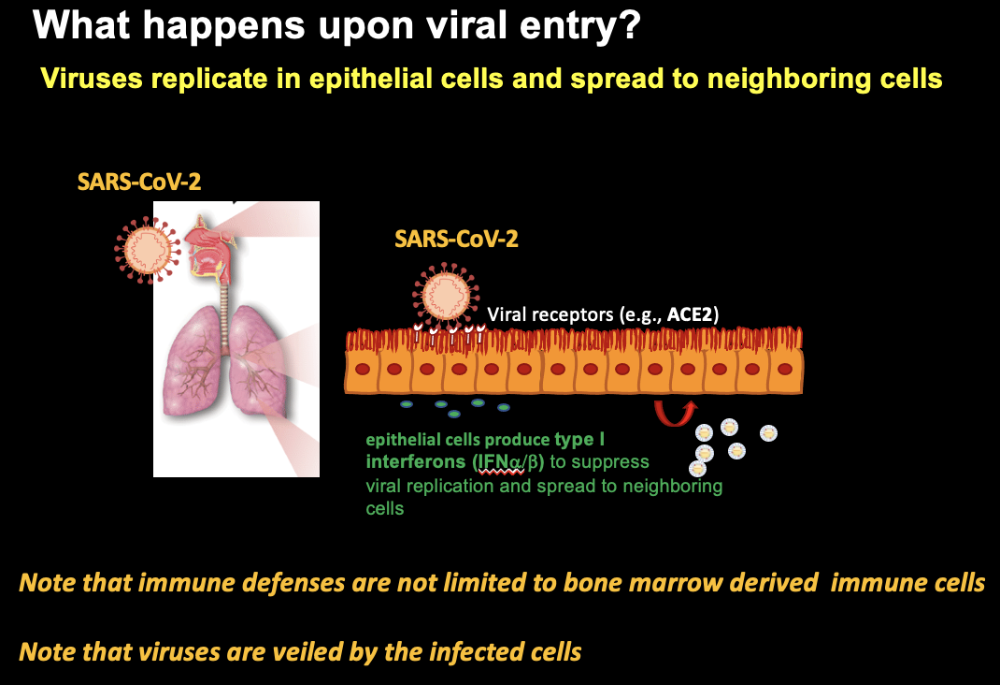
viruses replicate in epithelial cells and spread to neighboring cells
epithelial cells produce type I interferons (INF alpha/beta) to suppress viral replication and spread to neighboring cells
(immune defenses are not limited to bone marrow derived immune cells)
(viruses are veiled by infected cells)
explanation:
- viruses can bind receptors and go into cells
- viruses inside host cells are detected by specific type of
pattern recognition which looks for foreign RNA and DNA
- then this becomes engaged, the host cell (ANYWHERE IN THE
BODY, doesnt matter bc all host cells can produce INF
alpha (type I INF))
- INF alpha binds to
INF a receptor on neighboring cells, so
the neighboring cells are alerted that there is a viral
infection
- the neighboring cell then proceeds to impair viral replication
- INF alpha binds to
INF a receptor on neighboring cells, so
the neighboring cells are alerted that there is a viral
infection
- then this becomes engaged, the host cell (ANYWHERE IN THE
BODY, doesnt matter bc all host cells can produce INF
alpha (type I INF))
- thus, if a single virus gets into the neighboring cell that already received the INF a on its INF a receptor, the virus is unable to replicate in the neighboring cell
- this concept allows the body to keep the infection localized (whether is bacterial or viral) - keeping intruder localized = fundamental concept on how to deal w/ infections
- REMEMBER THIS CAN OCCUR IN ALL CELLS IN THE BODY
- neighboring cell does not allow viral
replication by shutting down protein synthesis = virus
cannot make viral progeny
- protein is necessary for protein translation
*** KEEP INFECTION LOCALIZED BY INNATE MECHANISMS IN ALL CELLS BY THIS (IN REGARDS TO VIRAL INFECTIONS)
what are the outcomes of INF-a secretion? How do NK cells recognize virally infected cells?
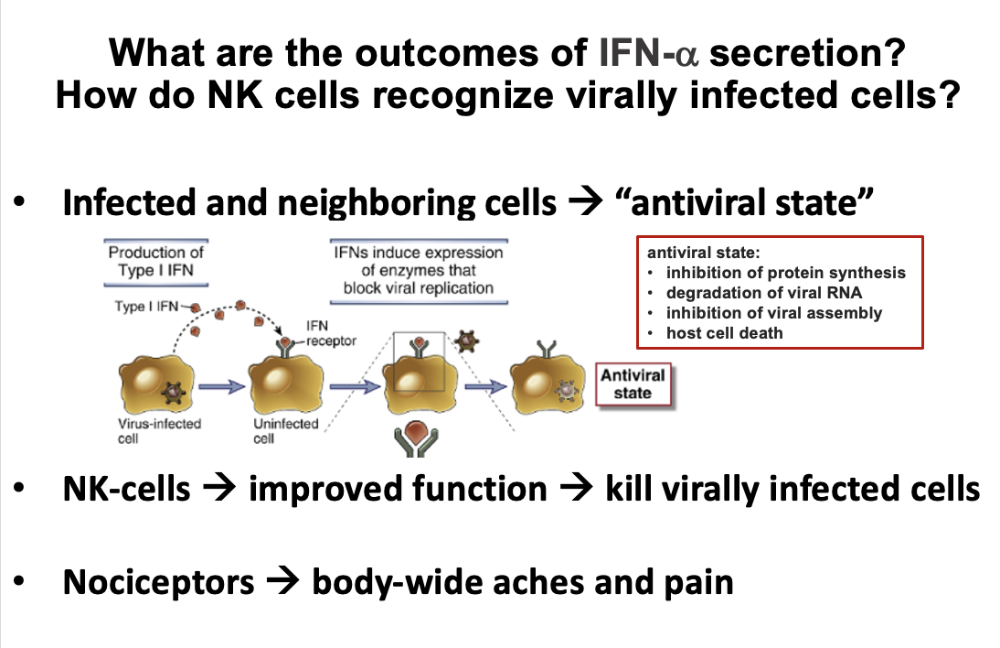
infected and neighboring cells -> "antiviral state"
NK cells -> improved function -> kill virally infected cells
nociceptors -> body wide aches and pains
production of type I INF from virally infected cell -> INF goes to INF receptor of uninfected neighboring cell -> neigboring cell goes into antiviral state
antiviral state:
- inhibition of protein synthesis
- degradation of viral RNA
- inhibition of viral assembly
- host cell death
explanation:
Induces expression of genes that convert the cell into an antivirus stage
Viral RNA degraded by Rnase
Stop viral assembly in cell - Proteins made that interfere
Host cell commit suicide – host cell death = no source for virus to gain from
Virus is clever – randomly make proteins (by chance) that work to interfere with the proteins of the host cell to defend against the virus
- there are proteins in covid that do this and interfere with antiviral response of host cell
NK cells
- recognize sick cells (hide receptors on cell surface) (MHC 1 proteins that are usually present on all nucleated cells)\
- by not showing it – allows the NK cell to attack
- triggers it to kill infected cell
Nocireceptors (pain receptors) are stimulated by type 1 INF
- if someone gets sick and hurting all over body – gives clue that it is very likely a viral infection, and INF alpha is released locally + go into circulation, which triggers pain receptors all over body = aches and pains of viral infection
many microbes find means to interfere with antimicrobial immune response
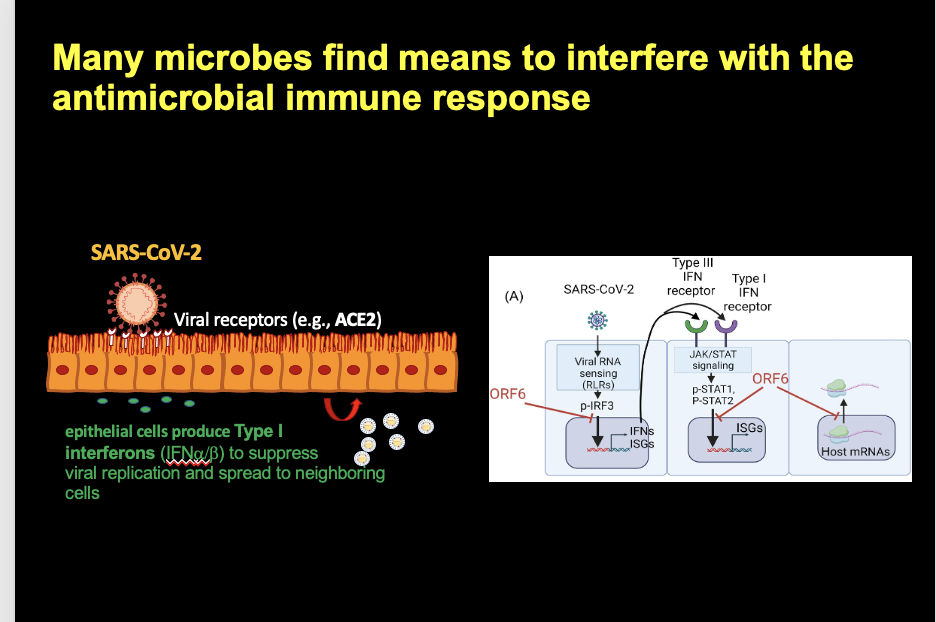
right side shows how innate immunity works:
- ??? confused bc no explanation?
dinstinguish innate responses to intracellular pathogens from adaptive immune responses
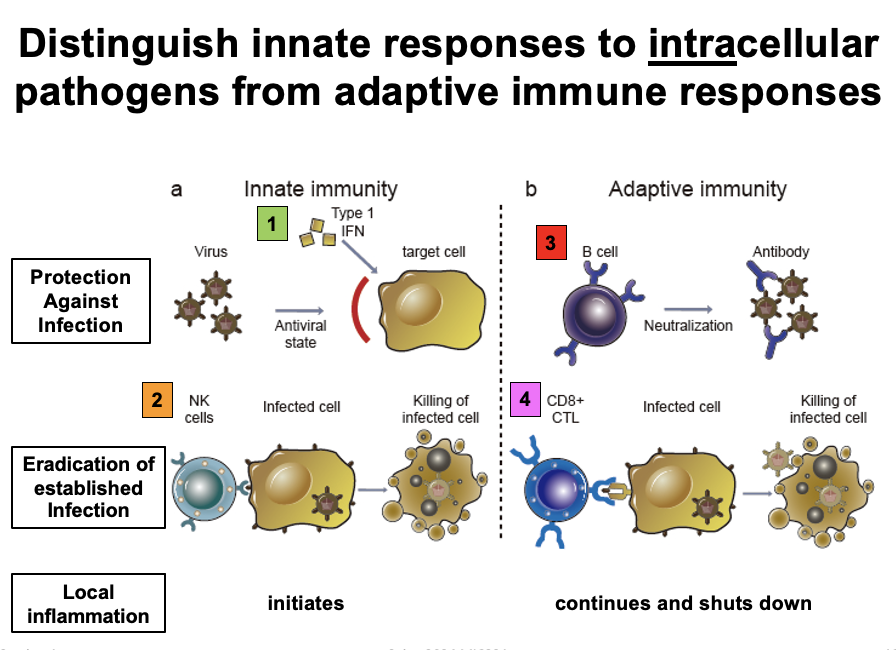
innate immunity:
- protection against infection
- type I inf goes to target cell, making it become antiviral
- eradication of established infection
- NK cells sense infected cell (bc doesnt have MHC receptors) and kills infected cell
- local inflammation
- initiates
adaptive immunity
- B cell neutralizes the virus using antibodies it has
that match with the antigen
- B cells make antibodies + bind virus = neutralize it = unable to bind to the ligand on the host cells
- CD8+ CTL (cytotoxic T cells)
interact with infected cells and kill them
- see small peptides of antigens
- antigen provides + signal to CD8 T cells, and they kill the infected cells
- continues and shuts down
NK cells neutralize infected cells which downregulate MHC type 1 expression
activated DCs bridge innate immunity and T-cells
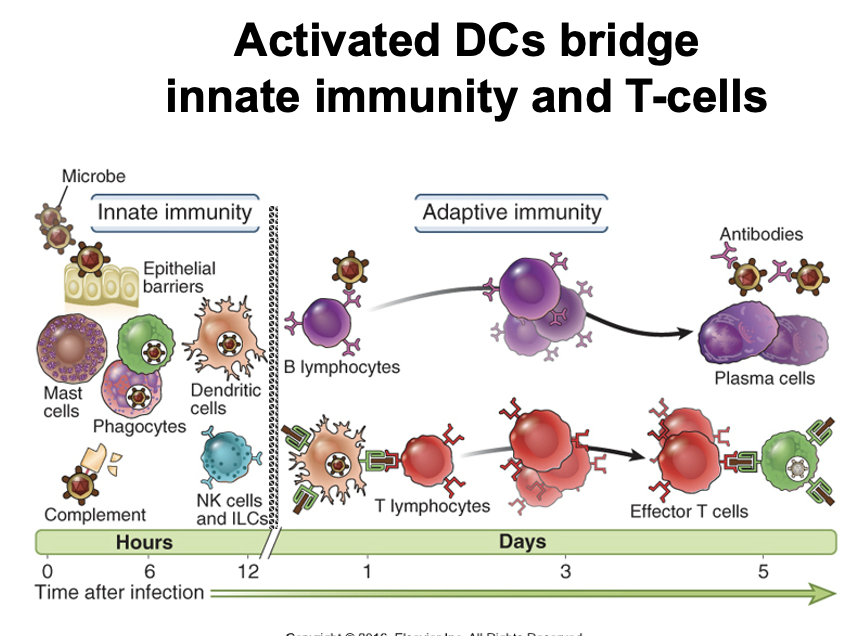
Dendritic cell: Eat fragments/debris from lysed cell -> crawl up lymphatic duct into draining lymph node -> where naïve T cell -> T cell activated = turn into effector T cell
- The 5 star general of adaptive immune responses
Some T cells are able to help B cells (helper T cell?)
B cells see antigens directly (don’t need dentritic cells to present them) and can see it independently
For immune response, antigen specific B AND T cell, must recognize same antigen = they must see same one together = team
- where do they find eachother? In draining lymph node
- within lymph node, there are specific areas – is a highway system of incredibly ingenious design
B cells make better (higher affinity) antibodies over time (and more)
- when make plasma cell, each clone can make 2000 molecules / second
= why effective in neutralizing pathogens
2 types of adaptive immunity
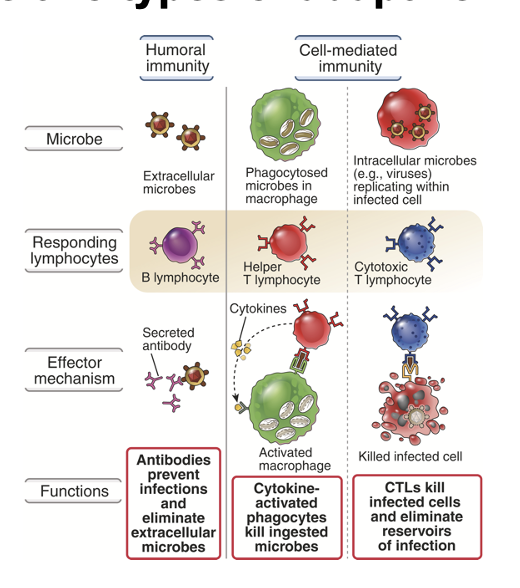
MAKE SURE UNDERSTAND THE SLIDE
- humoral immunity
- microbe - extracellular microbes
- responding lymphocytes - B lymphocyte
- effector mechanism - secreted antibody interact with the microbes
- functions - antibodies prevent infections and eliminate extracellular microbes
- cell mediated immunity
- microbe - phagocytosed microbes in macrophages and intracellular microbes (ex: viruses) replicating within infected cell
- responding lymphocyte - Helper T lymphocyte and cytotoxic T lymphocyte
- effector mechanism - activated macrophage (helper T lymphocyte) and killed infected cell (cytotoxic T lymphocyte)
- functions - CTLs kill infected cells and eliminate resevoirs of infection and cytokine activated phagocytes kill ingested microbes (helpter T lymph)
Antibodies advantage – if secrete into extracellular space they get everywhere
Must migrate from lymph node -> blood -> out of blood into site of infection (where inflammation is), only then will they re-recognize the antigen on the infected cell
- T cell is cell mediated, must go through this complex journey to find virally infected cell
- once have antibodies, is easy bc have so many of them
Igm = first antibody produced
Then there are Iggs
Then also Iga (present in most mucosal surfaces in gut and lungs) – provide initial protection
- the antibody gets outside of the “body” bc this one gets on SURFACE of barriers (so is outside of our actual body, just on our inner surfaces, like cavities)
- this is a place it neutralizes the virus
- effective means of infection prevention
Humoral and cell mediated immunity
properties of adaptive immunity
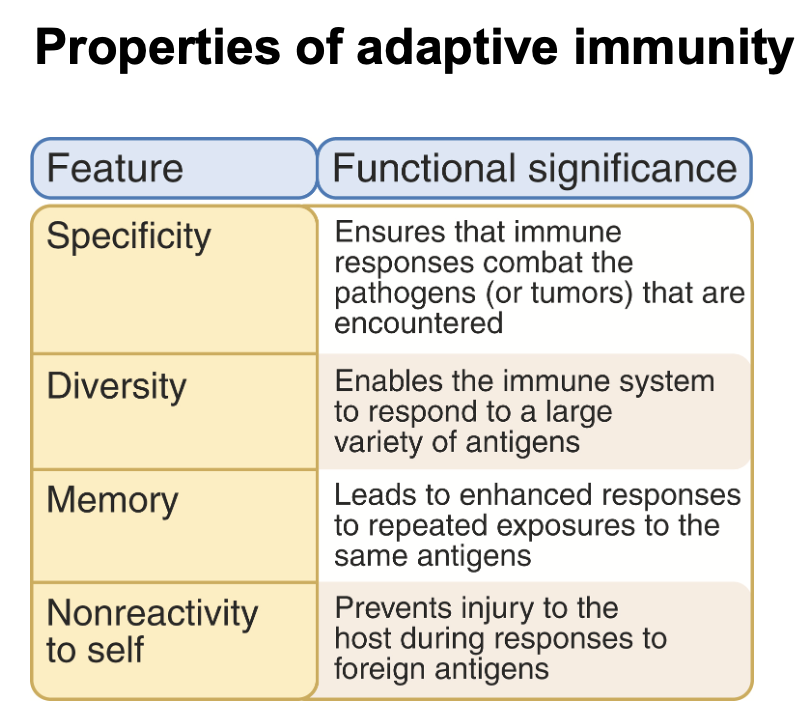
specificity
- significance: ensures that immune responses combat the pathogens (or tumors) that are encountered
- diversity: enables the immune system to respond to a large variety of antigens
- memory: leads to enhanced responses of repeated exposures to the same antigens
- nonreactivity to self: prevents injury to the host during responses to foreign antigens
specificity and diversity of lymphocytes, the holy grail of the adaptive immune system
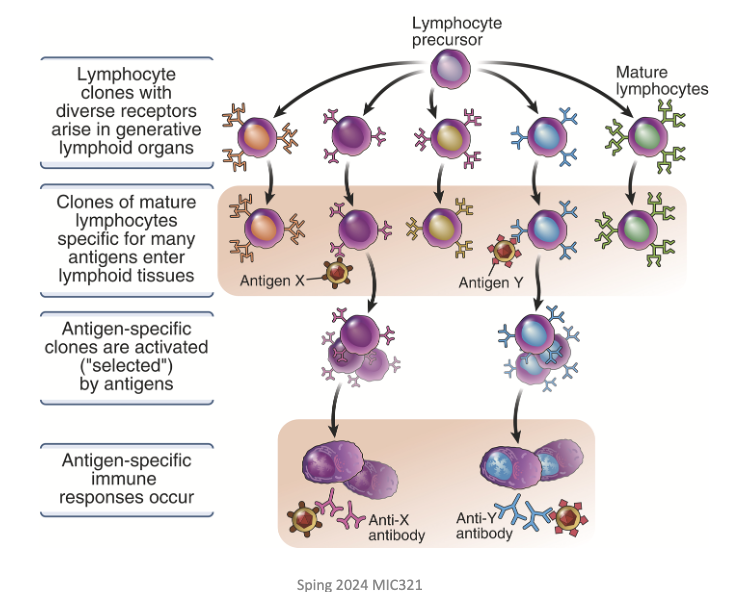
- precursor lymphocyte
- -> mature lymphocyte
- lymphocyte clones with diverse receptors arise in generative lymphoid organs
- clones of mature lymphocytes specific for many antigens enter lymphoid tissues
- antigen specific clones are activated (selected) by antigens
- antigen specific immune responses occur
Simple concept of adaptive immunity
Upper – precursor lymphocyte – go into development
Where antigen encounter occur = where adaptive immunity happens
- 1 lymphocyte seeing the correct antigen -> then expands clonally
- how adaptive immunity gets power
- sampling premade antigens exist (of sooooo many types), they already exist before virus/pathogen even enters body
- each clone has ability of making antibody/t cell receptor in millions of bodies = clonal expansion
B cells and CD8 T cells, BUT NOT CD4 T cells, acquire one major effector function
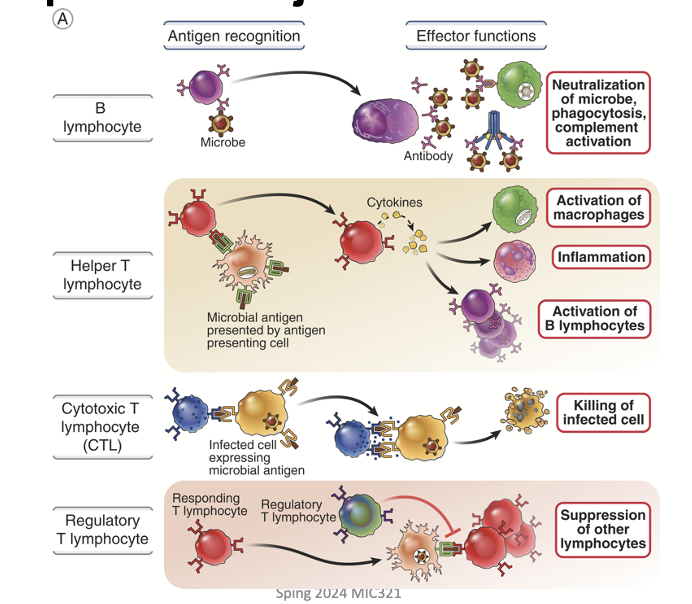
Activate CD8 T cells, generate molecules that can kill other cells
Activate B cell – make antibodies
CD4 T cells different – 3 star general of immune system
- told by dendritic cell to become helper cell
- diff type helper cells – help macrophage, can become more efficient killing pathogens, inhibit immune responses, etc.
- CD4 t cell to acquire these functions is instructed by dendritic cell (how it gains this immunological function)
= the CD4 T cell can have various functions, depending on how it is instructed by the dendritic cell
anatomy of adaptive T and B cell response
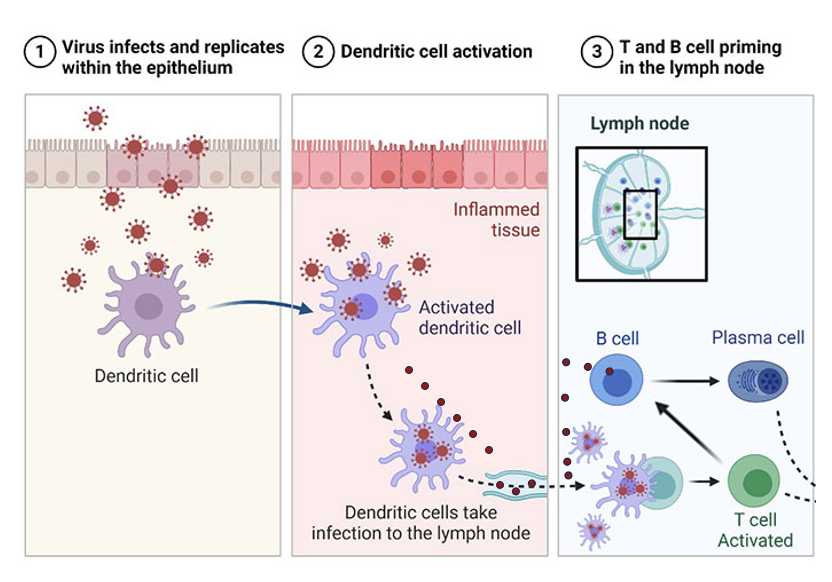
- virus infects and replicates within the epithelium
- dendritic cell activation -> dendritic cell take infection to the lymph node
- T and B cell priming in the lymph node
Without dendritic cell, can get into draqining lymph node
- make potent plasma cells
???
vaccination induces powerful and precise antibody responses that retain memory
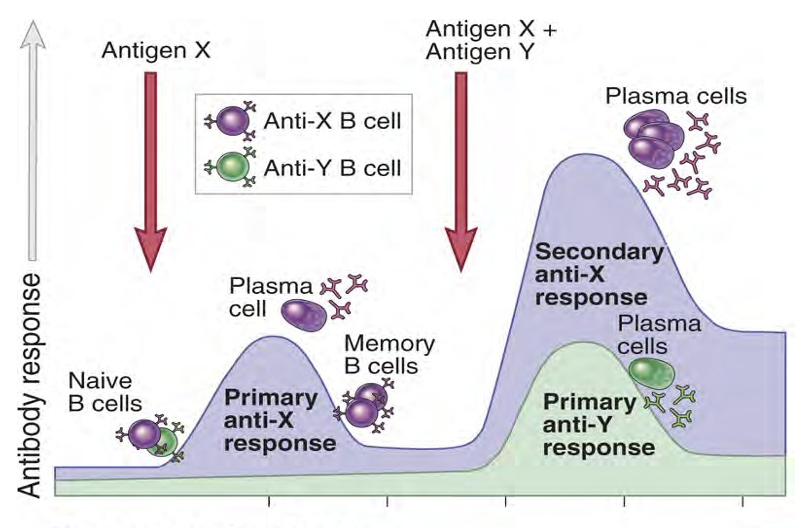
One of most important things – immune response is both innate and adaptive together is effective
Ability to protect vs same pathogen again is due to memory
Primary immune response on left
- magnitude shorter
- leaves memory cells (depicts memory B cells in picture)
- may take up to 7/10 days
- immune system is training and becomes optimized to fight so if pathogen come again, is already trained, adaptive immunity kicks into gear rapidly
- primary infection = principal of vaccination
- gain memory immunity
Memory of adaptive system is powerful – gives effective immunity vs specific pathogen
immune response to COVID-19 vaccination
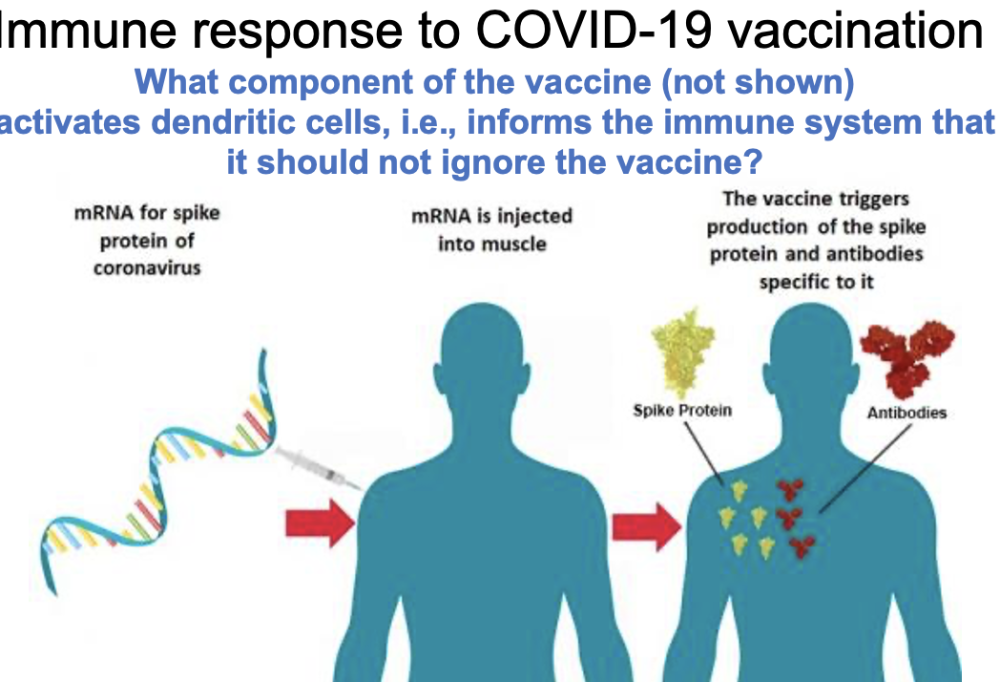
- what component of the vaccine (not shown) activates dendritic cells (i.e: informs the immune system that it should not ignore the vaccine)?
mRNA vaccine – protein made by cells is made by genetic code injected
Dendritic cell must sense a danger in order to work
- never mentioned
- besides mRNA in vaccines, there is something that activates the human dendritic cells
- commonly use: aluminum hydroxide
- many companies in biotech sector use these molecules to mimic activation of dendritic cells
- if there is too much, you have areas on body of inflammation
= there is more to vaccines than just using dead virus
- in real infection, dendritic activation comes from innate cells sensing pathogens
- in viruses, the RNA/DNA starts the dendritic response, bc they are different from our own
anti covid 19 vaccination antibody response
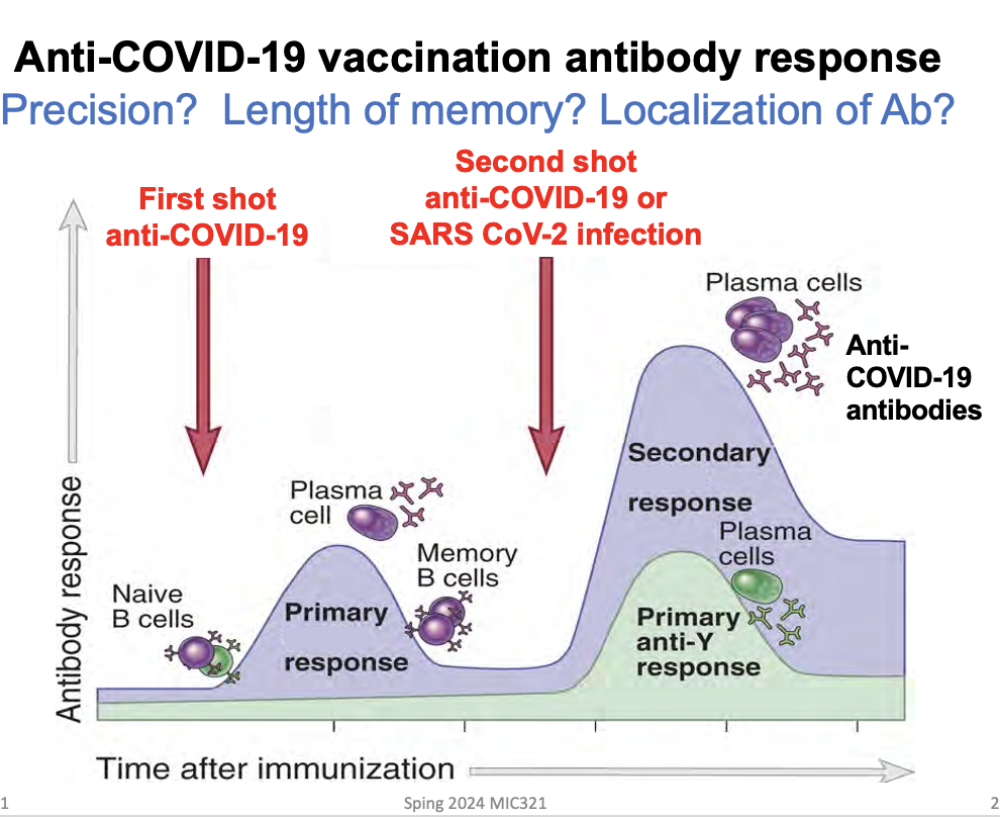
I mmune responses against b acteria ( e xtracellular) are different from antiviral responses
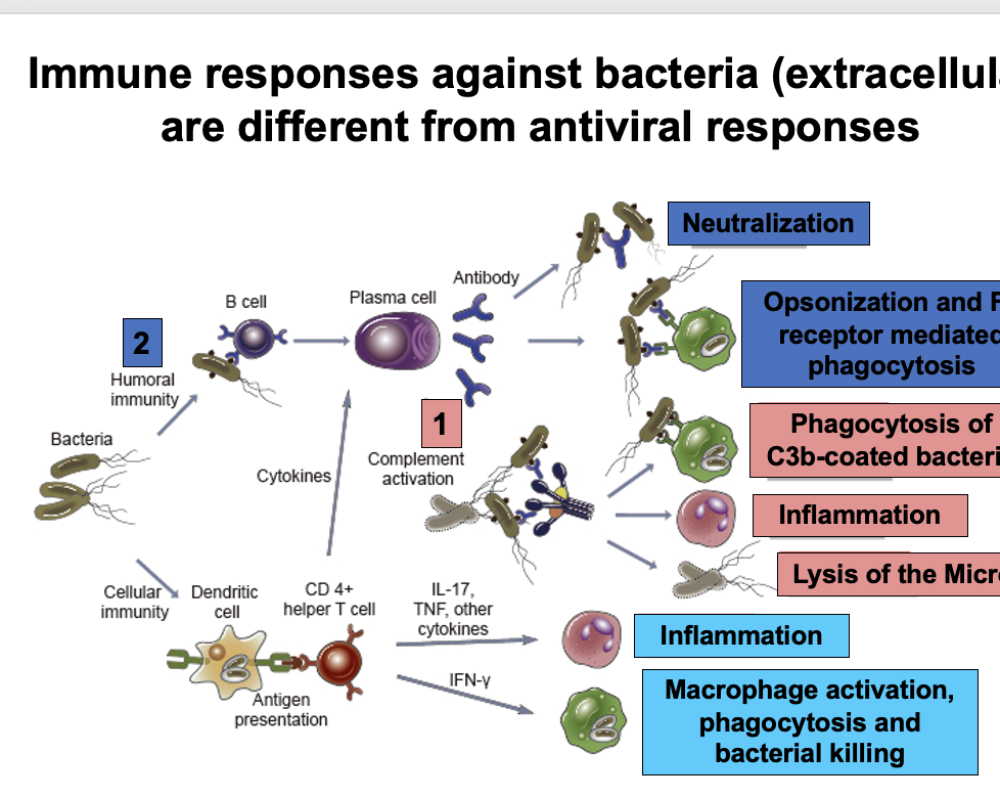
textbook notes week 1 (p. 1-14)
...
Chp 1 intro to immune system
- immunity - protection vs. infectious pathogens, allergies, tumor immunity, autoimmunity, etc.
- immune system - collection of cells, tissues, molecules that mediate reactions
- immune response - coordinated response
roles of immune system vs implications
1. defense vs infection
- deficient immunity - increase susceptibility to infection (Ex: AIDS)
- vaccine boosts immune defense + protect vs. infection
2. defense vs. tumors
- potential for immunotherapy of cancer
3. control of tissue regeneration and scarring
- repair of damaged tissue
4. cell injury and pathogenic inflammation
- immune responses = cause of allergic, autoimmunity, other inflammatory diseases, and for some of harmful consequences of infections
5. recognition of and injury to tissue grafts and newly introduced proteins
- immune responses = barriers to transplantation and gene therapy
infections and immunity
- most important function: prevent + eradicate infection
- defective immune response - inc. at risk for BAD infection
- using vaccines to stimulate response = best method to protect individual vs. infection
- pandemic usually subside when large fraction of population has
immunity (herd immunity)
- many pathogens infect widespread bc pop was not exposed to it prior (no immunity)
immunologic disorders
- not supposed to react to self molecules / harmless foreign antigens
- in some, immune system mounts damaging reaction vs.
self = autoimmune diseases caused
-
autoimmune disease characterized by rxns of
host cells (inflammation)
- usually
chronic bc antigens inciting cannot be
eliminated
- = damage normal tissue / can lead to organ dysfunction
- usually
chronic bc antigens inciting cannot be
eliminated
-
autoimmune disease characterized by rxns of
host cells (inflammation)
stages of host defense: innate + adaptive immunity
- defense vs. infection
- early: innate immunity
- natural/naive immunity
- always present in healthy ppl
- defense upon infection
- 1st line: epithelial barrier of skin + mucosal tissue
- epithelia (+ cells in/under epithelia) produce antimicrobial substances = block entry
- if enter body -> other innate components defend
- also initiate adaptive response
- later: adaptive
- specific / acquired immunity
- require proliferation/differentiation of lymphocytes in response to microbes before provide effective defense
- strong bc of inc in microbe specific
lymphocytes in response to infection
- highly specialized functions of diff classes lymphocytes + enhanced response of repeated exposure to same thing
- takes few days
- esp. important for pathogens that evolved to resist innate immunity
- antigen - any molecule specifically recognized by lymphocytes / antibodies
- early: innate immunity
divisions of labor - types of adaptive immunity (humoral and cell mediated)
divisions of labor: types of adaptive immunity
-
humoral immunity
- mediated by
antibodies - produced by B
lymphocytes
- antibodies enter circulation, extracellular fluid, etc.
- defend vs.
microbes present
- prevent microbes infect cells
- neutralize toxins from microbes
- enhance uptake of extracellular microbes to phagocytes = kill pathogens
- transported transplacentally to fetal circulation to protect
- mediated by B lymphocytes that secretet antibodies -> eliminate extracellular microbes
- mediated by
antibodies - produced by B
lymphocytes
microbe - extracellular
lymphocyte responding - B lymphocyte
effector mechanism - secreted antibody
function - antibodies prevent infections and eliminate extracellular microbes
2. cell-mediated immunity
- mediated by T lymphocytes
- antibodies (humoral) not effective for intracellular microbes, they just work extracellular (can prevent infection of these cells)
- cell mediated immunity important for intracellular pathogens
- 2 major types T lymphocytes
- cytokine producing helper T lymphocytes -> activate phagocytes to destroy microbes ingested + are in phagocytes
- cytotoxic T lymphocytes - kill any type of host cells that harbor infectious microbes (ex: virus in cytoplasm)
- some helper T lymphocytes -> promote defense vs. extracellular microbes by recruiting phagocytes
microbe - phagocytosed microbe in macrophage (OR) intracellular microbe in infected cell
responding lymphocyte - helper T cell (OR) cytotoxic T cell
effector mechanism - activated macrophage signaled by cytokines of helper T lymphocytes (OR) cytotoxic T cells kills infected cells
functions - cytokine activated phagocytes kill ingested microbes (OR) CTLs kill infected cells + eliminate reservoirs of infection
T cells mostly recognize peptide fragments of protein antigen presented = sense intracellular microbe
active immunity
individual exposed to antigens of microbe -> mount response to eradicate infection + dev resistance to later infection by same microbe ( immune now )
- "naive" for microbe - never exposed to it / not resistant to it
passive immunity
naive person receive antibodies from another already immune person / protective antibodies from labs
- *resistance is NOT long lived
- ex: new borns have mom's antibodies (via placenta and milk)
- ex: passive immunotherapies of cancers
properties of adaptive immune response
...
specificity + diversity
adaptive system capable of distinguishing millions of antigens (specificity)
- makes sure response is vs. specific microbe
- each lymphocyte has single antigen receptor - recognizes only 1 antigen
- must have
enough diff lymphocytes to detect any possible antigen (total
repertoir is about 0.5x10^12 B and T lymphocytes) and millions of
clones
- specific clones have the same antigen receptor
- clones of lymphocytes specific for diff antigens dev before encounter w/ antigen
- antigen cause immune response by activating the specific lymphocyte
- specificity - ensures that immune reponses combat pathogens (or tumors) encountered
- diversity - enables immune system to respond to large variety of antigens
-
memory - leads to enhanced response to repeated
exposure to same antigens
- adaptive system have faster, larger, more effective response to repeated exposure to same antigen -> imply immune system remembers every encounter w/ antigen = immunologic memory
-
primary immune response - response to 1st
exposure to antigen
- initiated by lymphocytes (naive lymphocytes) seeing antigen for 1st time
- secondary response - subsequent
encounters w/ same antigen lead to these larger + more rapid +
eliminate antigen better
- generate bc of memory lymphocytes (induced from primary response)
- each exposure to same microbe generate more memory cells + activate previous ones = optimize ability immune cells to combat recurrent infection
-
nonreactivity to self - prevents injury to host
during responses to foreign antigen
- immunologic tolerance -
unresponsiveness to self
- immune system ability to tolerate self molecules. if not, then autoimmune issues
- immunologic tolerance -
unresponsiveness to self
cells of adaptive immune system
from progenitors in bone marrow
-
myeloid cells
- phagocytes - neotrophils/macrophages
- antigen presenting cells (APCs)
- mast cells
- many are in tissues + are sentinels to detect presence of microbes + initiate response
-
lymphoid cells
- lymphocytes - only cell that makes clonally distributed receptors FOR diverse antigens + are key mediators of adaptive immunity
- naming - cluster of
differentiation (CD)
- CD4+ - helper
T cell
- B cell activation (humoral) - help them make antibodies
- macrophage activation (cell mediated)
- stimulate inflammation
- CD8+ -
cytotoxic T cell (CTL)
- kill infected cells w/ intracellular microbes + tumor cells (cells haboring microbes)
-
regulatory T cells
- suppress function of other T cells (regulation of immune responses, maintenance of self-tolerance)
- B cells
- antibody production (humoral)
- ***ONLY
CELL THAT MAKES ANTIBODIES - MEDIATES HUMORAL
IMMUNITY
- express membrane bound antibodies that = receptors to recognize antigens + initiate process of activation of cells
- antigens can bind these receptors on B lymphocytes = proliferation + differentiation of antigen specific B cell
- CD4+ - helper
T cell
antigen receptors of T lymphocytes recognize
peptide fragments of protein antigens bound to specialized peptide display molecule (MHC) on surface of other cells (antigen presenting cells)
all lymphocytes come from common progenitor cells in bone marrow
B lymphocytes mature in bone marrow
T lymphocytes mature in thymus
once mature, leave these generative lymphoid organs -> circulation and secondary lymphoid organs (major site of immune response) where encounter antigens
naive lymphocytes
- express receptor for antigen but doesnt perform the function required to eliminate antigens
- circulate btw secondary lymphoid organs
- eventually apoptose if unused (not activated by antigen)
- differentiation + proliferation initiated by antigen recognition
effector lymphocytes
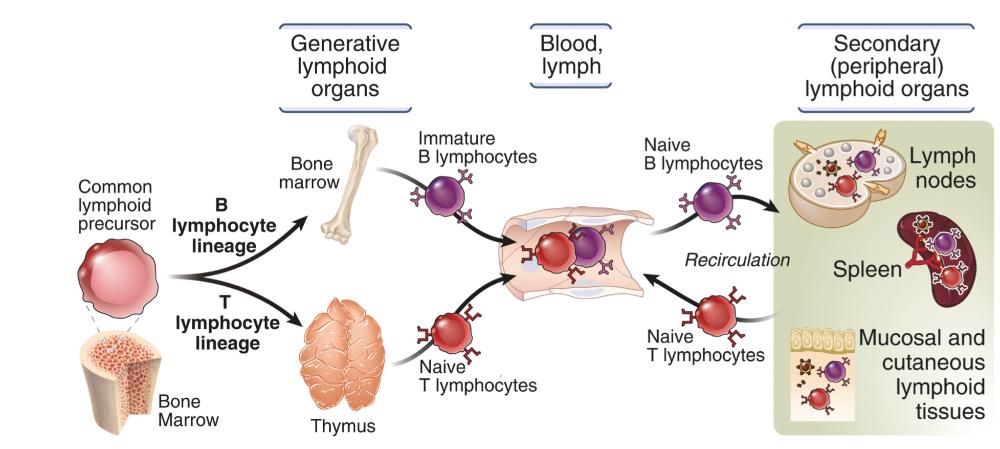
differentiated progeny of naive cells that have ability to produce molecules that function to eliminate antigens
- effector cells of B lymphocytes lineage - antibody secreting
cells (plasma cells)
- from B cells in response to stimulation, in secondary lymphoid organ
- can stay to make antibodies, some in blood (plasmoblasts)
- plasma cells make antibodies for years (long lived)
- = protection if reinfected
effector CD4+
helper T cells
- make proteins (cytokines) that activate B cells, macrophages, etc.- mediate helper function
effector CD8+ T cells
(CTLs) kill infected host cells (as above)
memory cells
- also from progeny of antigen stimulated lymphocytes
- inactive unless stimulated by same antigen that induced their
development
- initiate secondary immune response
antigen presenting cells
- common entry for microbes (skin, GI, resp, genitourinary) have cells on epithelia that capture antigens, transport them, and present them to lymphocytes